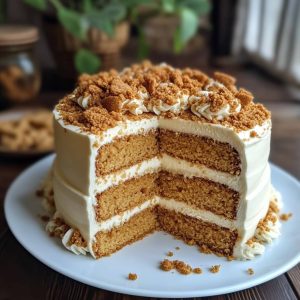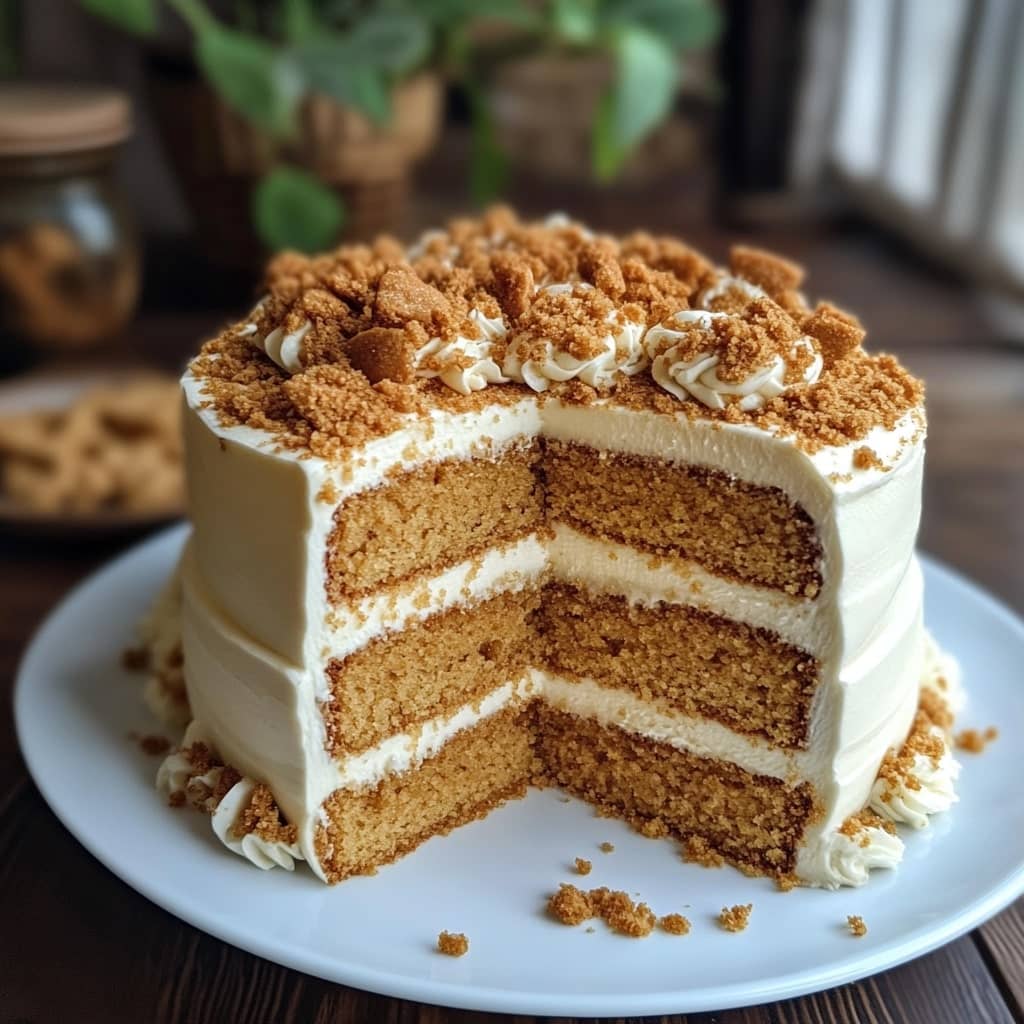Biscoff Cake
Biscoff Cake is a rich and flavorful dessert that incorporates the iconic Biscoff cookies and spread, offering a unique twist on traditional cake recipes. This dessert is loved for its deep caramelized flavor, which is the signature taste of Biscoff cookies. The cake is often paired with a smooth, creamy frosting, creating the perfect balance of sweetness and texture. Whether you’re a fan of Biscoff or new to it, this cake will quickly become a favorite. It’s perfect for special occasions, afternoon teas, or any time you’re craving a sweet treat that’s both comforting and indulgent.
The History of Biscoff Cake
Biscoff cookies, originally known as speculoos in Belgium and the Netherlands, have a long history rooted in European baking traditions. The cookies gained significant popularity worldwide after the Lotus Biscoff brand introduced them to international markets. The creation of Biscoff Cake comes from a modern culinary trend to incorporate the flavors of Biscoff into cakes, cupcakes, and even ice cream. This dessert gained traction particularly due to its rich, spiced flavor, which reminds many of caramel and cinnamon. Biscoff Cake continues to be a favorite among dessert lovers who enjoy the complex taste profile of the cookies and spread in baked goods.
Ingredients Breakdown
To create a delicious Biscoff Cake, you will need the following ingredients: Biscoff cookies are the star ingredient, giving the cake its signature flavor. Biscoff spread is used both in the cake batter and as a key ingredient in the frosting, adding richness and creaminess. The basic cake ingredients include flour, sugar, eggs, butter, and baking powder, all of which form the base of the cake. For the frosting, you’ll need cream cheese, powdered sugar, and a bit more Biscoff spread. Additionally, a splash of vanilla extract enhances the overall flavor of the cake. Each of these components works together to create the perfect balance of flavor and texture.
Step-by-Step Recipe
To start, preheat your oven to 350°F (175°C) and grease and line your cake pans. Begin by crushing the Biscoff cookies into fine crumbs. In a large mixing bowl, whisk together the flour, baking powder, and crushed Biscoff cookies. In a separate bowl, cream the butter and sugar until light and fluffy, then add eggs one at a time, beating well after each addition. Slowly incorporate the dry ingredients into the wet mixture, alternating with the addition of milk until the batter is smooth.
Pour the batter into the prepared cake pans and bake for 25-30 minutes, or until a toothpick comes out clean. While the cake cools, prepare the frosting by beating the cream cheese, butter, and Biscoff spread together until smooth. Gradually add the powdered sugar, one cup at a time, and continue to beat until the frosting is fluffy. Once the cake layers have cooled, spread a layer of frosting between them and cover the entire cake with the remaining frosting. Optionally, garnish with crushed Biscoff cookies for extra texture.
Tips for the Perfect Biscoff Cake
For the perfect Biscoff Cake, ensure that your butter and eggs are at room temperature before mixing. This will help create a smooth batter and a light, fluffy texture in your cake. When crushing the Biscoff cookies, make sure they are finely ground to avoid large chunks in the batter. It’s also essential to sift the dry ingredients to prevent clumps and ensure an even distribution. If you want a more intense Biscoff flavor, add extra Biscoff spread to the batter or frosting. For an added touch, you can drizzle melted Biscoff spread on top of the frosted cake for a beautiful finish.
Variations and Customizations
You can easily customize Biscoff Cake to suit your preferences. For a lighter cake, try substituting some of the butter with yogurt or sour cream. If you’re looking for a more decadent cake, consider adding a layer of caramel or chocolate ganache between the cake layers for extra richness. You can also experiment with different frosting types; for example, a chocolate frosting would pair beautifully with the spiced flavor of the Biscoff cake. For those who enjoy a bit of crunch, sprinkle some crushed Biscoff cookies on top or even incorporate them into the frosting for added texture.
Health Considerations and Nutritional Value
While Biscoff Cake is undeniably delicious, it’s also quite indulgent, with a rich base of butter, sugar, and Biscoff spread. The cake contains a good amount of calories and sugar, making it more of an occasional treat rather than a daily snack. If you’re looking to make it a bit lighter, you can reduce the amount of sugar or substitute with a sugar alternative. You can also try using whole wheat flour for a slightly healthier option, though it will alter the texture. As with any dessert, moderation is key, but this cake offers a sweet way to enjoy the unique flavors of Biscoff in a cake format.
FAQ
Can I use a different type of cookie for this cake?
While Biscoff cookies are the main flavor profile of this cake, you could experiment with similar cookies, like speculoos or gingersnap cookies, though it will change the flavor.
Can I freeze Biscoff Cake?
Yes, you can freeze the cake layers and frosting separately. Wrap the cooled cake layers tightly in plastic wrap and freeze them for up to 2-3 months. Thaw in the fridge overnight before frosting.
Can I make the frosting ahead of time?
Yes, you can make the frosting ahead of time and store it in the fridge for up to a week. Allow it to come to room temperature before frosting the cake.

Biscoff Cake
Ingredients
Biscoff Cake Layers
- 3 cups all-purpose flour 375g
- 1 cup granulated sugar 200g
- 2 cups packed dark or light brown sugar 400g
- 2 1/2 tsp baking powder 10g
- 2 tsp ground cinnamon 5g
- 1 tsp fine salt 6g
- 1 cup unsalted butter room temperature (226g)
- 1 cup pasteurized egg whites from a carton or 7 large egg whites room temperature (235g)
- 1 1/2 cups buttermilk room temperature (360g)
- 2 Tbsp vegetable oil 28g
- 2 tsp vanilla extract 8g
Vanilla Buttercream Frosting
- 3 cups unsalted butter room temperature (678g)
- 1 Tbsp vanilla extract 12g
- 1 1/2 tsp fine salt 9g
- 11 cups powdered sugar 1375g
- 1/3 cup heavy cream or whipping cream 80g
Cookie Butter Buttercream Frosting Add-Ins
- 1 cup cookie butter 390g
- 1/4 cup heavy cream 60g
Additional Decorations and Filling
- 12 Biscoff cookies cut into small pieces
- 1 cup cookie butter 390g
- French piping tip
Instructions
Biscoff Cake Layers:
- Preheat the oven to 350°F/175°C. Line four 7-inch or three 8-inch pans with parchment rounds and grease them with non-stick baking spray or homemade pan release.
- In a stand mixer (using a paddle or whisk attachment) or with a hand mixer, combine 3 cups all-purpose flour, 1 cup granulated sugar, 2 cups brown sugar, 2 1/2 tsp baking powder, 2 tsp cinnamon, and 1 tsp salt until fully combined.
- Add 1 cup unsalted butter to the dry ingredients on low speed. Mix until no large chunks of butter remain and the mixture resembles a crumbly texture.
- Pour in 1 cup egg whites and mix on low until incorporated.
- Next, add 1 1/2 cups buttermilk, 2 Tbsp vegetable oil, and 2 tsp vanilla extract, mixing on low speed until fully combined. Scrape the sides of the bowl with a rubber spatula, then beat on medium speed for 30 seconds to ensure everything is well-mixed.
- Divide the batter evenly between the prepared pans. I recommend using a digital scale to ensure each pan contains the same amount of batter for uniform cake layers.
- Bake for 33-35 minutes or until a toothpick comes out with a few moist crumbs. Rotate the pans halfway through baking for even results.
- Allow the cakes to cool in the pans for 10 minutes, then use a small offset spatula to separate the cake from the pan’s edges.
- Place the cake layers in the freezer for 30 minutes to speed up the cooling process. Once cooled, carefully flip the pans and remove the layers.
- If you wish to level the tops, use a serrated knife just before assembling the cake, or you can wrap and freeze the layers if preparing them in advance.
- For frozen layers, let them thaw for about 20 minutes before assembling. The layers should still be slightly cold, which will make them easier to assemble.
Vanilla Buttercream Frosting:
- While the cake layers bake and cool, prepare the buttercream.
- Beat 3 cups unsalted butter with a paddle attachment on medium speed for 30 seconds until smooth.
- Add 1 Tbsp vanilla extract and 1 1/2 tsp salt on low speed.
- Slowly add 11 cups powdered sugar, one cup at a time, while mixing on low speed. Add 1/3 cup of heavy cream halfway through to make mixing easier.
- Continue mixing on low speed for a few minutes until the desired consistency is reached.
- If the frosting is too thick, add heavy cream (1 Tbsp at a time). If too thin, add more powdered sugar (a quarter cup at a time).
- Scoop 2 cups of the vanilla frosting into a separate bowl for the cookie butter frosting and set aside.
- Cover the remaining vanilla frosting with plastic wrap to prevent it from crusting, then set aside.
Cookie Butter Frosting:
- Combine 1 cup of cookie butter and 1/4 cup heavy cream into the 2 cups of vanilla buttercream. Stir with a rubber spatula until fully incorporated and smooth.
- Cover with plastic wrap and set aside.
Assembling the Biscoff Cake:
- Assemble the cake on a greaseproof cake board or flat plate. Use a dab of frosting to help stick the first cake layer to the board.
- Spread an even layer of vanilla frosting on top of the first cake layer, then chill the cake in the freezer for 5 minutes.
- Next, spread a layer of cookie butter frosting on top of the vanilla frosting, then drizzle 1/4 cup of warm cookie butter over the frosting. Repeat this layering process until all the cake layers are stacked.
- Apply a thin coat of frosting around the cake to fully cover the layers and lock in any crumbs.
- Smooth the frosting with a bench scraper, then chill the cake in the fridge for 20 minutes or the freezer for 5 minutes until the frosting is firm to the touch.
- Apply a thicker layer of vanilla frosting around the cake and smooth it with the bench scraper.
- Press chopped Biscoff cookies around the cake. Use larger cookie chunks at the base and smaller bits higher up to create a cookie gradient.
- Pipe a border around the top of the cake using a French piping tip with the remaining frosting.
- Finish with a final drizzle of warm cookie butter and enjoy!

